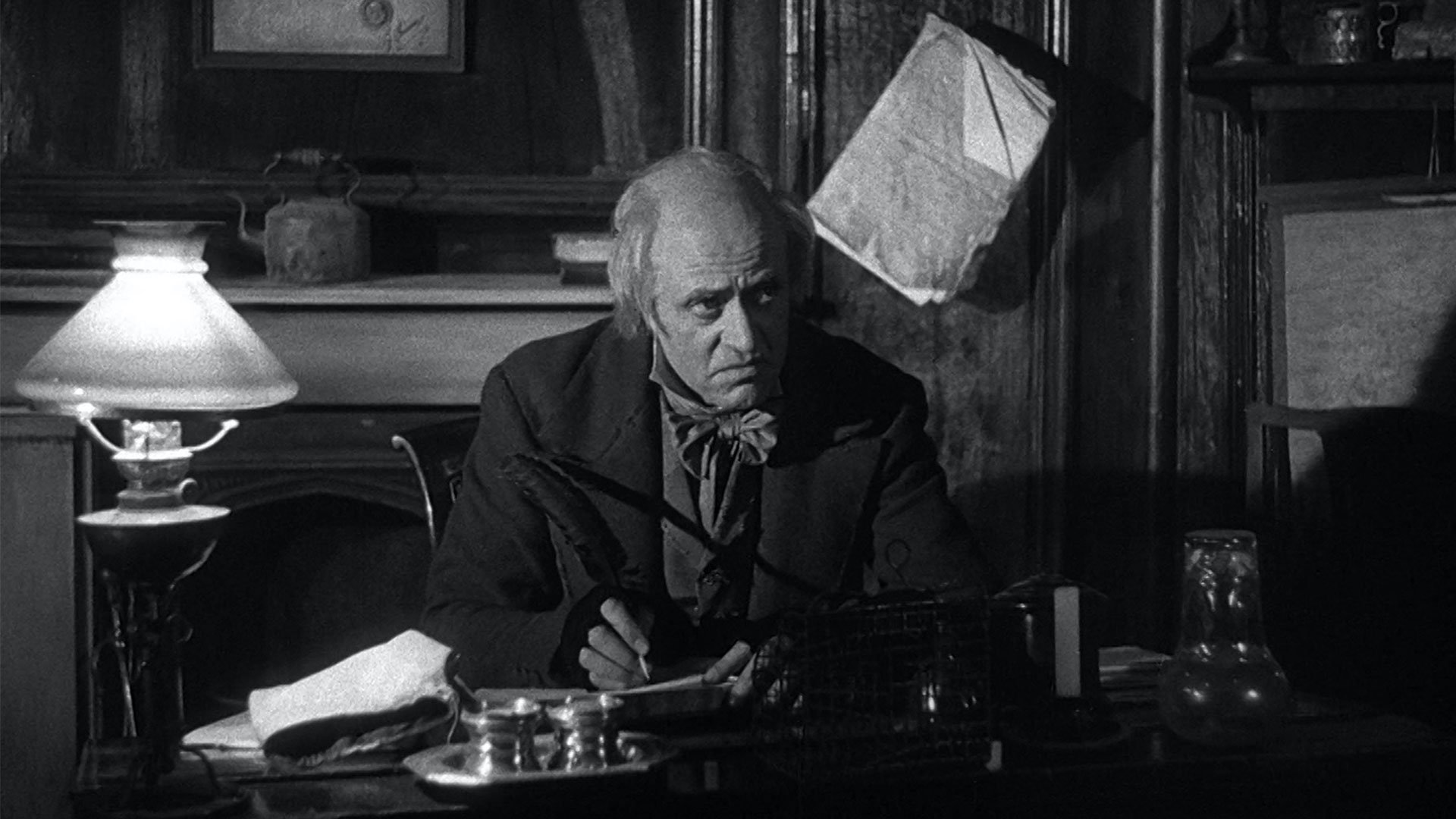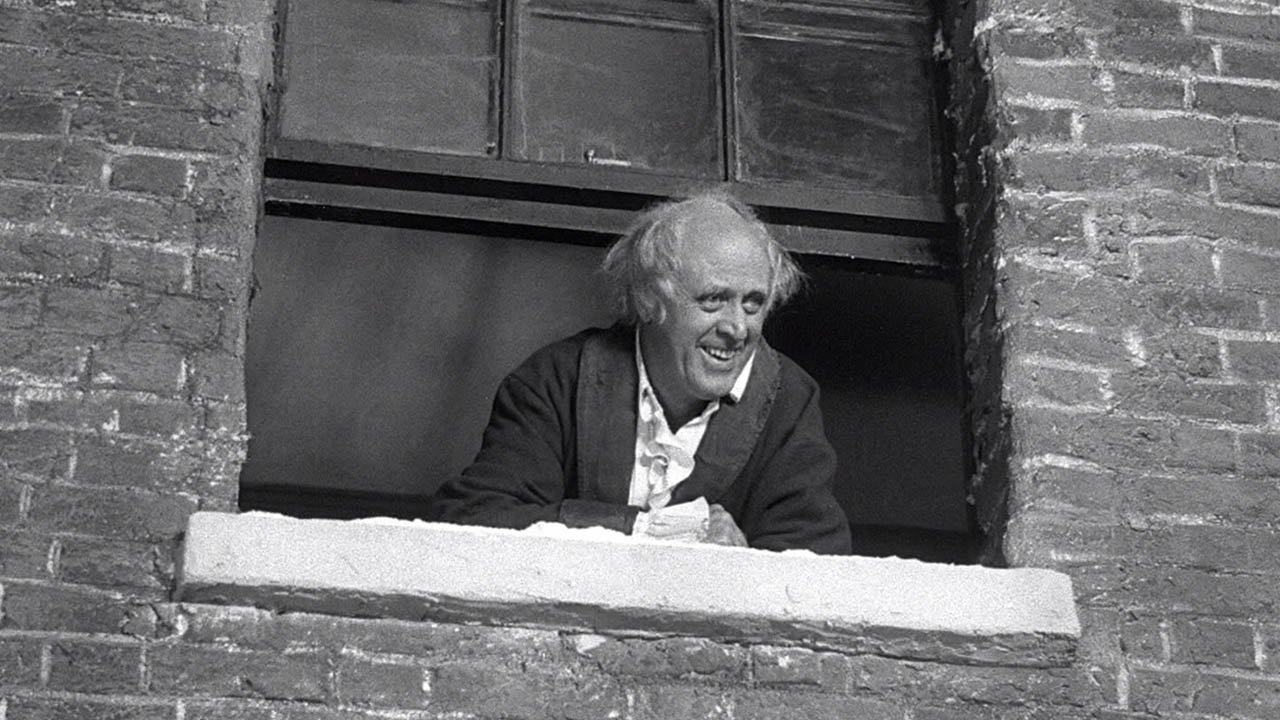“Scrooge (1951)” Review
Alistair Sim stars in “Scrooge” as the titular miser turned saint in the best adaptation of Charles Dickens’ classic story.
If you’re to ask yourself what the most well-known Christmas story is, it’s obviously the birth of Jesus. However, if you’re to ask what the second most well-known Christmas story is, it’s obviously “A Christmas Carol.” Ever since the dawn of cinema, there have been adaptations and parodies of the 1843 Charles Dickens’ novella and some of them get pretty strange. There are adaptations of this story featuring Mr. Magoo, The Flintstones, The Muppets and Mickey Mouse, with the latter two being excellent portrayals. However, when it comes to my favorite version of “A Christmas Carol,” it’s 1951’s “Scrooge.”
I first saw the film on a VHS tape on loan from my local video store when I was eight years old. You’re probably thinking, what kind of eight-year-old seeks out a black-and-white film from 1951 on purpose? What can I say, I always was a bit peculiar. From a very young age, I loved the Charles Dickens story and its many adaptations. I remember when I was young and being introduced to the story via Mickey Mouse, The Muppets and even a decent direct-to-video animated film starring Tim Curry as Ebenezer Scrooge. However, I had never really seen a live-action version of the story that didn’t involve Kermit the Frog. When I popped in the tape and watched this decades old film, I was hooked and I still watch this film often around the holidays. This year, I’ve already seen it twice.
For the ten people left in the world who don’t know the story, I’ll give the synopsis. Set in Victorian London, Ebenezer Scrooge (Alistair Sim) is a shrewd moneylender who cares not for the suffering of the poor nor the good feelings of Christmas. His only friend, fellow businessman Jacob Marley (Michael Hordern), has been dead for seven years and he’s neglectful of the only two people who seem to care about him: his faithful clerk Bob Cratchitt (Mervyn Johns) and his nephew Fred (Brian Worth). However, upon being visited by Marley’s ghost, Scrooge discovers that his soul may be redeemed by being visited by three spirits who show him the Christmases of the past, present and future respectively. Through these visions, Scrooge sees what effect he has on people’s lives and how he can become a force for good instead of corrupt greed.
What I love about this film is how subtle it is, yet engaging. Unlike so many “Christmas Carol” adaptations, which try so hard to be over-the-top and ride the coattails of a great story, “Scrooge” plays it straight and embraces the more traditional elements of the novella while changing elements of the story for the better.
Sim’s redemption arc over the film is one of the most satisfying out of any adaptation of “A Christmas Carol.”
Not only is “Scrooge” my favorite version of “A Christmas Carol,” it also has my favorite Ebenezer Scrooge. Alistair Sim perfectly embodies Scrooge and part of that is because he was mainly a stage actor as opposed to a film actor. Many other great Scrooge performances have the issue that a famous person is playing them. Rarely do I see an actor disappear into the role which is a shame since greats like Albert Finney, Michael Caine, Jim Carrey and Patrick Stewart have all taken on the role. Really, the only other actor to have become Scrooge without drawing attention to the actor behind the miser is George C. Scott.
Sim not only is subtle in his approach, but his performance is strongly layered. When he is confronted by the two businessmen who wish to raise money for the poor, he doesn’t just look disgusted, he’s appalled. But when he sees elements of his past, like being an apprentice to Mr. Fezziwig, he’s absolutely joyful. While so many of the lines, straight out of Dickens’ original work, are well-known, Sim doesn’t overplay them. He’s very quiet and methodical as one of English literature’s most famous characters.
I also give plenty of credit to the actor playing Scrooge as a young man, George Cole. While Sim certainly understands Scrooge as an old man looking back upon his past, Cole’s performance is just as layered as you see this bright young lad become corrupted by the world around him, eventually becoming a hardened shell of his former self. One of Cole’s best scenes involves the death of Fan, Scrooge’s beloved older sister, while she gave birth to Fred. At first, Scrooge is hopeful that his sister will get well but, when she dies, he quickly becomes hardened and we begin to see the resentment that Scrooge will feel towards his nephew.
While “A Christmas Carol” is a gothic story that involves being transported to various points in time by ghosts, so many tellings go too far into the magical side of things to where we forget that the story is about a mortal becoming a better person. While the Ghosts of Christmases Past, Present and Future (Michael J. Dolan, Francis de Wolff, Czeslaw Konarski) are excellent, there’s not a ton of magic applied to them. They seem less like enchanted creatures and more like guiding Biblical angels.
This is especially apparent in the depiction of the Ghost of Christmas Yet To Come, who often looks like a dementor from “Harry Potter.” In “Scrooge,” the ghost is simply a pale man in a cloak which is far more intimidating. It reminds me of the depiction of Death from “The Seventh Seal,” a corpse that we’re all to become.
With remarkable depictions of ghosts like the one of Christmas Future (right), “Scrooge” has some of the most heartwarming and startling portrayals of the iconic spirits in “A Christmas Carol.”
But it’s not just Scrooge and the Ghosts that are integral to the story. Bob Cratchit and his lame son Tiny Tim (Glyn Dearman) are the people that are constantly being affected by the actions of Scrooge. Mervyn Johns’ performance of Bob Cratchit is one of the sweetest you’ll ever see. His dedication to Scrooge is admirable as is the love he has for his family. However, when it comes to Tiny Tim, I find that he’s the weak link of the story.
To be fair, I have never seen a truly outstanding portrayal of Tiny Tim and I heard someone explain it brilliantly. Tiny Tim is a hard character to capture. He’s supposed to be wiser than his age and that’s hard to play genuinely by any actor, let alone a child. Glyn Dearman is trying his best and his reading of “God Bless Us Everyone” is plenty iconic, but I’m more concerned about Bob Cratchit and his reactions to Tim’s illness than Tim’s welfare.
As far as the tone goes, “Scrooge” brilliantly captures the gothic atmosphere but never overdoes it. Instead of being incredibly dark with a forced happy ending or too delightful without the necessary elements of fear, the balance is perfect. There’s plenty of joyful and frightening moments and the redemption that Scrooge undergoes is exceptional.
While many adaptations of “A Christmas Carol” try to repeat everything from the book word-for-word, there are some changes made. One thing that the film added to Dickens' story is that the reason Fan died was because of childbirth, which explains Scrooge’s resentment towards Fred. Scrooge’s mother also died while giving birth to him which caused his own father to resent him. This is a brilliant change because it not only explains this part of the story but also creates a parallel between Scrooge and Fred.
It’s also common for adaptations to show the failed romance of Scrooge and Belle, renamed Alice (Rona Anderson) for the film, due to Scrooge’s obsession with money. The film makes a brilliant change by showing what Alice is like in the present. She is depicted to be happy and fulfilled helping the poor which devastated Scrooge, reminding him of his failure to appreciate what he had.
What makes “A Christmas Carol” so endearing is the redemption of Scrooge and its powerful message of selfless giving and helping your fellow man. While so many Christmas films try to shamelessly manipulate you by exploiting a good message, this story has stood the test of time with how simple and charming it is. With an iconic leading performance and a brilliant depiction of this iconic tale, “Scrooge” still remains a Christmas classic over 70 years later.




